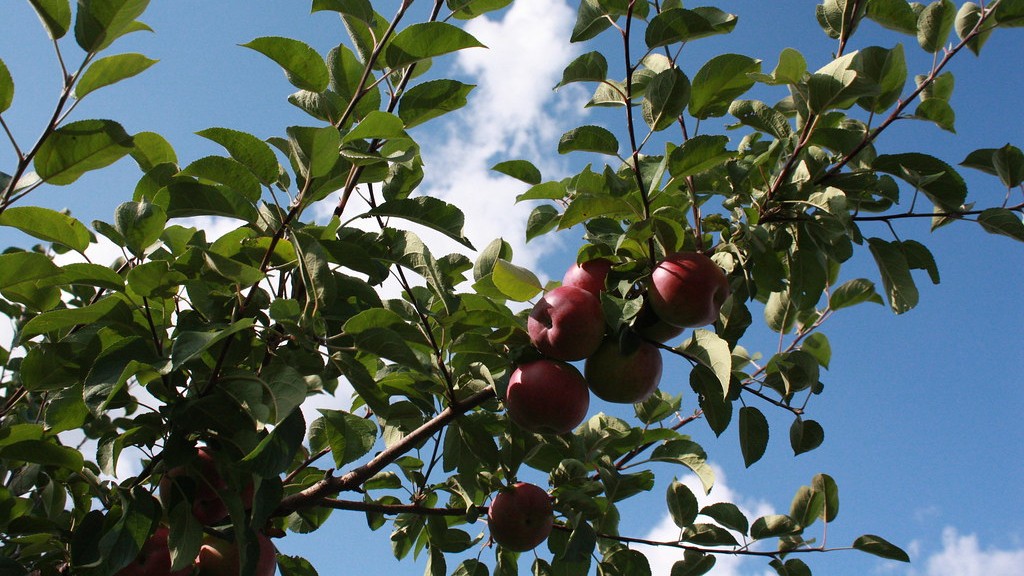When should I plant my apple tree? Planting your apple tree at the right time is one of the most important steps in ensuring a successful harvest. Apple trees can be planted in either late winter/early spring, or in late summer/early fall. The best time to plant depends on where you live and the climate of your region.
Apples require a lot of sun and cooler temperatures to ripen and thrive. Thus, they are best planted in the late winter or early spring in the northern states, or from late fall to early winter in the southern states. For example, most areas in the Northeast and Midwest should plant in early spring, while areas in the Southeast should plant in late fall. If possible, you should try to make sure your apple tree receives a full day of sun every day.
Strategically positioning your tree will also increase the chances of a successful harvest. Apple trees should be planted on higher ground to avoid water puddles from forming around their roots. They should also be placed in an area with well-draining soil in order to provide the best environment for their roots.
Once planted, apple trees should be fertilized regularly to ensure they remain healthy and are able to grow. Fertilizer should be applied every 4-6 weeks in the spring and in the fall. Organic fertilizers are best, as they provide essential nutrients for the tree and help ensure the soil remains healthy.
Finally, it’s important to prune your apple tree. Pruning encourages new growth and helps the tree retain its structure. Prune away broken and diseased branches, as well as excess growth. Prune in the late winter before new growth begins, and lightly prune throughout the summer and fall as needed.
The Benefits of Planting an Apple Tree
Planting an apple tree has many benefits. Not only will it help sustain your family’s food supply, but it can also provide some valuable aesthetic and environmental benefits as well. Apple trees are attractive and can add a touch of beauty to any yard. They can also provide shelter and food for birds and other wildlife.
Furthermore, apple trees are a great way to teach children about the environment and gardening. By planting an apple tree, children can learn about things like species and biomes, as well as the importance of sustainability and resource management. These are just a few of the benefits of planting an apple tree.
Buying and Planting an Apple Tree
When purchasing an apple tree, you should always buy from a reputable nursery or online retailer. Choose a tree that is free from any visible damage or disease. The tree should also have a firm root system and a healthy-looking trunk and branches. If possible, inspect the tree before purchasing, to make sure it is healthy and strong.
Once you’ve purchased the tree, it’s time to plant it. Make sure you’ve chosen the right spot that gets plenty of sun, and dig an area large enough to accommodate the root system of the tree. Make sure you mix in organic fertilizers before planting the tree, and water it thoroughly. Finally, cover the area with mulch to insulate the roots.
Caring for an Apple Tree
Once your apple tree is planted, it’s important to ensure it thrives by providing it with enough sunlight, water, and fertilizer. A newly planted tree should be watered every 2-3 days, or at least 2-3 times a week. During the winter months, you can reduce the frequency of watering. As mentioned earlier, apply fertilizer to the tree every 4-6 weeks. In addition, use an organic pesticide to protect the tree from pests and disease.
Apple trees should also be pruned regularly to promote new growth and ensure the tree maintains its structure and health. Prune away any broken or diseased branches, as well as excess growth. Pruning should be done in the winter and lightly throughout the rest of the year as needed.
Harvesting Apples
When it comes to harvesting your apples, you’ll need to wait until they’re ripe. Apples will be ready to pick when they are bright in color and their stems become dry and brittle. To harvest, gently twist the apple off the tree, being careful not to damage the branch. Store the apples in a cool and dry place to keep them fresher for longer.
Best Varieties for Your Climate
It’s also important to choose the right variety of apple tree for your climate. Research the different types and look for ones that are able to thrive in your region. Some popular varieties include Gala, Fuji, and Honeycrisp. When selecting a variety, consider the size, taste, and color of the apple, as well as blooming period and cold hardiness.
Pest and Disease Management
Apple trees are subject to pests and disease, especially if they are not cared for properly. The most common pests are aphids, mites, and caterpillars. To help prevent pests, keep an eye out for signs of damage. If you do find signs of pests, use an organic pesticide to ward them off. Keep in mind that excessively using pesticides can make some insects resistant, so use with caution.
As for diseases, the most common ones include fire blight, apple scab, and cedar apple rust. Make sure to do regular inspections of your apple tree, looking for signs of disease. Remove any areas of damage and try to maintain good air flow to help prevent diseases from forming. Again, organic treatments should be used to help contain the spread of any disease.


